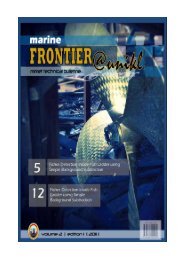click here to download - UniKL MIMET Official Website
click here to download - UniKL MIMET Official Website
click here to download - UniKL MIMET Official Website
Create successful ePaper yourself
Turn your PDF publications into a flip-book with our unique Google optimized e-Paper software.
engineering and hybrid breeding technology<br />
have made it possible <strong>to</strong> alter the physical prop‐<br />
erties of vegetable oils by changing their fatty<br />
acid profiles. This has allowed an improvement<br />
of the oxidation stability by increasing the oleic<br />
content of the oil. The resulting high oleic base<br />
s<strong>to</strong>ck oils with additional antioxidants have<br />
been shown <strong>to</strong> be as good as or better than<br />
petroleum oils in oxidation stability trials [10].<br />
Examples of the usage of vegetable oil based<br />
hydraulic fluids are the Sawfish logging robot<br />
deployed by the Tri<strong>to</strong>n Logging, a Canadian<br />
company, in Lois Lake, British Columbia. The<br />
underwater robot harvested submerged trees<br />
using a hydraulic grappling pincer and electric<br />
chain saw. The hydraulic grappler is powered<br />
with vegetable oil instead of petroleum based<br />
or synthetic based hydraulic fluids. The com‐<br />
pany aim is <strong>to</strong> harvest the dead but well pre‐<br />
served submerged forest thus eliminating the<br />
need <strong>to</strong> cut down living trees onshore and at<br />
the same time did not pollute the aquatic envi‐<br />
ronment of the lake [12].<br />
Feasibility of Palm‐Oil Based Fluid<br />
Many research and developments of hydraulic<br />
fluids made from vegetable oils has been done in<br />
Europe and the United States focusing on rape‐<br />
seed, soybean and canola oils by various inde‐<br />
pendence and government sponsored labora<strong>to</strong>‐<br />
ries such as the New York’s Brookhaven National<br />
Labora<strong>to</strong>ry, Albuquerque’s Sandia National Labo‐<br />
ra<strong>to</strong>ry and the University of Iowa as early as<br />
1991 [2,6]. These researches and the subsequent<br />
commercial products show that rapeseed and<br />
soybeans oils are suitable for hydraulic fluids<br />
base oils and with its additives, able <strong>to</strong> perform<br />
almost equally with petroleum based and syn‐<br />
thetic fluids. However, these oils are sources and<br />
processes in Europe or the United States and <strong>to</strong><br />
utilize these environmentally friendly oils in the<br />
South East Asia region will be costly in term of<br />
<strong>MIMET</strong> Technical Bulletin Volume 1 (2) 2010<br />
imports and transportation. Further with the<br />
region own petroleum reserves especially in Ma‐<br />
laysia, it is more economic <strong>to</strong> continue using pe‐<br />
troleum based hydraulic fluids rather than im‐<br />
porting the bio fluids from overseas.<br />
As one of the world <strong>to</strong>p vegetable oil, palm oil<br />
can be a possible choice for further development<br />
as a base oil for hydraulic fluids especially since<br />
palm oil can be found in abundance in Malaysia.<br />
Palm oil contains over 40% oleic acid and around<br />
35% palmitic acid. Almost 60% of fatty acids of<br />
the oil are unsaturated while stearic, palmitic<br />
and myristic are saturated [13]. The suitability of<br />
palm oil as hydraulic fluid base oil is compared<br />
with other vegetable oil through the melting<br />
point and iodine values as shown in table 1 be‐<br />
low.<br />
Table 1: Common vegetable oil melting<br />
points and iodine values [11]<br />
The iodine value is a measure of unsaturation of<br />
vegetable oil. The saturated property of the oil<br />
imparts a strong resistance <strong>to</strong> oxidative rancid‐<br />
ity. Thus the thermal and oxidative of the oil can<br />
be improved if the oil has lower iodine value. A<br />
high iodine value indicates that the oil needs <strong>to</strong><br />
be mix with ethylene oxide and/or propylene<br />
| MARINE FRONTIER @ <strong>UniKL</strong><br />
66



